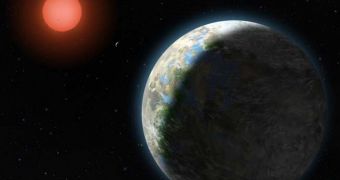Astronomers at the University of California in Santa Cruz (UCSC) say that the extrasolar planet Gliese 581g exists after all. The team originally identified the world in 2010, but a Swiss group shed doubts on its existence a few weeks later. Now, the UCSC experts say the other researchers are wrong.
Gliese 581g is the fifth planet around the Gliese 581 star, which is located relatively close to Earth. Back in September 2010, when the world was first identified, researchers said that it laid right in the middle of its parent star's habitable zone.
This is the area in any star system where temperatures are just right to support the existence of liquid water. Earth is located right at the heart of the Sun's habitable zone, while Mars and Venus orbit just outside its boundaries.
The discovery was widely covered by the media, since it implied that liquid water may exist on the alien world; and where there's water there may be life. However, just weeks after the announcement, a prominent team of astronomers at the Geneva Observatory in Switzerland said the planet is not there.
Investigators published a study showing that their analysis of the star system found all the previously detected planets around Gliese 581, except the one the UCSC group said could support life. The rebuttal led to a heated debate in the international astronomical community.
Now, the group in California publishes a paper suggesting that Gliese 581g is visible in the Swiss team's data after all. Details of the research will be published on August 1, in the German scientific journal Astronomische Nachrichten.
In an email interview for Space, the leader of the USCS group, astronomer Steve Vogt, explains that all data and analyses conducted to date “point to there being at least one other planet beyond the confirmed 4, a 5th planet, with a period in the 26-39-day regime.”
He goes on to say that Gliese 581g would theoretically have a mass just 2 to 3 times larger than that of Earth, and that its orbit would be situated right in the middle of its parent star's habitable zone. Gliese 581 lies around 20 light-years away from Earth.
For the September 2010 study, the USCS group used radial velocity data from the High Accuracy Radial Velocity Planet Searcher (HARPS spectrograph) on the European Southern Observatory's (ESO) 3.6-meter telescope at La Silla, in Chile.
Additional data were collected using the High Resolution Echelle Spectrometer (HIRES) spectrograph on the W. M. Keck Telescope, in Hawaii. Both instruments confirmed the existence of Gliese 581g.
“The take-away message is, regardless of who eventually gets bragging rights to the discovery of the first truly confirmed habitable Earth-sized planet, we are starting to find them in unexpected numbers, and unexpectedly nearby,” Vogt adds.
“That means there are many, many out there, at least tens of billions or more, in our own galaxy alone,” he concludes.

 14 DAY TRIAL //
14 DAY TRIAL //